During the off-season on Chappaquiddick, when the beaches belong to hardy walkers and the occasional snowy owl, some new seasonal visitors are showing up in increasing numbers: seal pups, vulnerable-looking creatures with speckled white fur, large dark eyes, and long whiskers, “hauled up” on the beaches for a rest. Their fat, full-grown parents are around too, perched on rocks off Squibnocket or outside Woods Hole, close enough to be seen by keen-eyed ferry passengers.
Just a generation ago any seal sighting would have made news around the Cape and Islands, where seals had been driven to virtual extinction after decades of bounty hunts and commercial sealing. “It was a real special treat for people that were driving on the beach or walking on the beach to see a gray seal poke its head up,” said Chris Kennedy, the beach superintendent on Martha’s Vineyard and Nantucket for The Trustees of Reservations, which manages, among other beaches, the Cape Pogue Wildlife Refuge and the Wasque Reservation. “And now it’s fairly common, it’s no longer a big deal. It’s something we expect to see whenever we go out, especially in the winter and spring.”
It’s not exclusively an off-season phenomenon, either. On almost any given day of the summer you can see seals hanging around not far from shore under the Gay Head Cliffs at Pilots Landing, for instance. Those who fish from boats, meanwhile, have grown accustomed to seeing (and probably cursing at) seals up and down the Vineyard-facing coast of the Elizabeth Islands, just across Vineyard Sound. Surfers, meanwhile, have grown used to seeing them at Squibnocket, Stonewall, and “the Painted House.”
These local seals are a piece of a larger story playing out in the region, where seals have gone from hunted to protected, scarce to abundant. And, according to most experts, the Vineyard could be just at the beginning of the curve. Which is to say there are likely more seals on their way. There are now three documented breeding areas south of Cape Cod, all largely uninhabited stretches of land. Muskeget Island, just eight miles across the channel from Wasque, is the largest. Seals are also well established on Monomoy, the National Wildlife Refuge that extends south off of Chatham. Video taken last spring over South Monomoy from a low-flying plane shows mile after mile of seals hauled up along the coastline, like so many sunflower seeds, forming a thick line between the dunes and the waves.
Most recently, and perhaps with the most potential impact on the Vineyard, a small breeding colony has established and produced a handful of pups on Noman’s Land, just three miles from Squibnocket Point. “We’ve seen adults there for the last several years,” said Stephanie Wood, a researcher with the protected species team at the National Oceanic and Atmospheric Administration’s (NOAA’s) Northeast Fisheries Science Center in Woods Hole who did her dissertation work on the recovery of U.S. gray seals. “It’ll be interesting to see what happens.”
Interesting on many levels, because the unambiguous conservation success story about gray seal recovery becomes fraught as fishermen sound the alarm about sharing the water with the fish-eating predators, and others worry about the white sharks that arrive to eat the seals. Like the wolves of Yellowstone, one’s opinion about the resurgence of gray seals in the waters around the Vineyard depends largely on one’s perspective.
“It’s very possible for an animal to go from rare and endangered to popular to a nuisance,” said Sean Hayes, protected species branch chief at the Northeast Fisheries Science Center. “And that can happen to any species. From the short-term perspective, we’ve gotten them from rare...to recovering,” he said.
“We’ve done a good job. But then it’s a fine tipping line.”
On Cape Cod, where the recovery of the seal population appears to contribute to the recent abundance of white sharks, and on Nantucket, where seals have learned to take anglers’ fish right off their hooks, some say the tipping point to annoyance already has been crossed. Seals are expanding their range southward from Maine and Canada, and if they haven’t shown up in particularly high numbers on the Vineyard yet, that may be because so far they have concentrated in less inhabited stretches of beach.
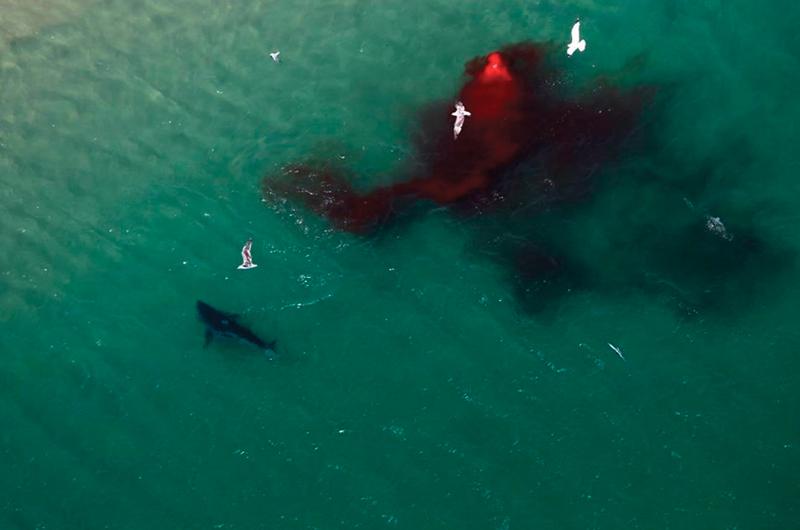
From his vantage as steward of beaches here and on Nantucket, Kennedy said he sees an inevitable reckoning on the Vineyard. “Let’s look down the road five or ten years,” he said. “I think it would be silly not to expect that we won’t have a larger seal population here, especially on Chappy, which is fairly close to the large colony on Muskeget Island that is just a few miles away.
“At some point I think it’ll also be our turn to have to deal with a large seal population.”
While most of the attention is on the gray seals, there are actually two main species of pinniped that are considered to be native to the waters around Cape Cod and the Islands: gray seals and harbor seals. Archaeological studies at several spots around the Vineyard have unearthed bones from both species, an indication that not only were seals present in local waters, they were regularly hunted by the local Wampanoag people long before the arrival of European colonists in the 1640s.
In southern New England, gray seals were given the nickname “Nantucket horseheads” for the long, equine snouts on males. The species’ Latin name, Halichoerus grypus, is hardly more flattering: “hook-nosed sea pig.” The pig reference is apt: gray seals are particularly adaptable and smart foragers, able to dive to several hundred feet and willing to gorge on a huge variety of fish, crustaceans, and the occasional seabird. Bulls grow to be almost 900 pounds and ten feet long, and compete with other males on land during mating season. Harbor seals are dainty by comparison, with dog-like snouts. Males weigh up to 245 pounds. They are primarily seasonal residents in Cape waters, mate at sea, and these days often travel to the coast of Maine or New Hampshire for pupping season.
Beyond the archeological record showing they existed, there is little information about seal numbers around the Cape and Islands prior to the 1900s. But there were enough for New Englanders to wish them gone. Beginning in the late 1800s, Massachusetts and Maine instituted a seal bounty hunt, with awards ranging from $1 per seal tail to $5 per seal (whole skin and nose required) in later years. The bounties, which were in place intermittently between 1888 and 1962, stemmed from “a perception and concern about competition for resources,” explained NOAA’s Wood. “For seals the resource concern would be fisheries. The idea would be to reduce the seal population and therefore reduce competition for fish between humans and seals.”
A 2009 study by Barbara Lelli, David E. Harris, and Abou El-Makarim Aboueissa showed that almost 41,000 seal bounties were paid in the two states while the bounty was in place, though records are incomplete. And the payouts don’t account for seals that were “struck and lost” during the hunt – killed or injured but not turned in. There was also fraud: hunters used seal hides to manufacture fake noses and tails and collect multiple bounties from one seal. But the broad estimate is that between 72,284 and 135,498 seals were killed during the bounties, which slowed over time as seals became less abundant. While harbor seals were the main target of the bounties, gray seals were hit harder. Although numbers are hard to come by, seal populations globally were also under increasing pressure throughout the nineteenth century from commercial hunting for both fur and oil products. By the mid-1900s both gray and harbor seals were considered virtually extirpated in New England.
Negative views of seals among fishermen persisted despite the collapse, according to the study, and the authors concluded that “there may be no level of seal population reduction, short of total extirpation, sufficient to change fishers’ attitudes towards these animals.” Attitudes among the general public, however, were shifting. In 1962 the seal bounty was repealed in Massachusetts, and just a few years later, in March 1965, state law was amended to levy a $500 fine against anyone who detained, hunted, hurt, or killed a gray seal. Perhaps most important, in 1972 the Marine Mammal Protection Act was passed by the U.S. Congress and signed by President Richard Nixon, setting broad protections for seals along with other pinnipeds, whales, dolphins, sea otters, manatees, and even polar bears. The act imposed civil and criminal penalties for hunting, killing, or even coming too close to the animals.
It took thirty to forty years of protection for the gray seals to come back to what is now considered to be a healthy and growing population, as the large colonies that survived in Canada slowly reclaimed their former range. According to Kimberly Murray, the coordinator of the seal research program at NOAA’s Northeast Fisheries Science Center, the main source of New England gray seals is Sable Island, in Nova Scotia. That population grew “exponentially” between 1960 and 1997 before slowing down, she said, and appears to be reaching a carrying capacity of sorts.
The exact number of seals in New England today is hard to pinpoint, given the movements of the population, but scientists are trying with a combination of aerial surveys, Google Earth, thermal imaging, drones, and examination of pupping rates. They estimate the gray seal population around the Cape today hovers around 25,000 (some estimates say up to 50,000), part of a much larger North Atlantic population. And according to Murray, unlike the Sable Island population, the New England population does not appear to have reached a stable maximum.
“We don’t have that much information in our waters to be able to say that,” she said. “Right now it still looks like it’s increasing.”
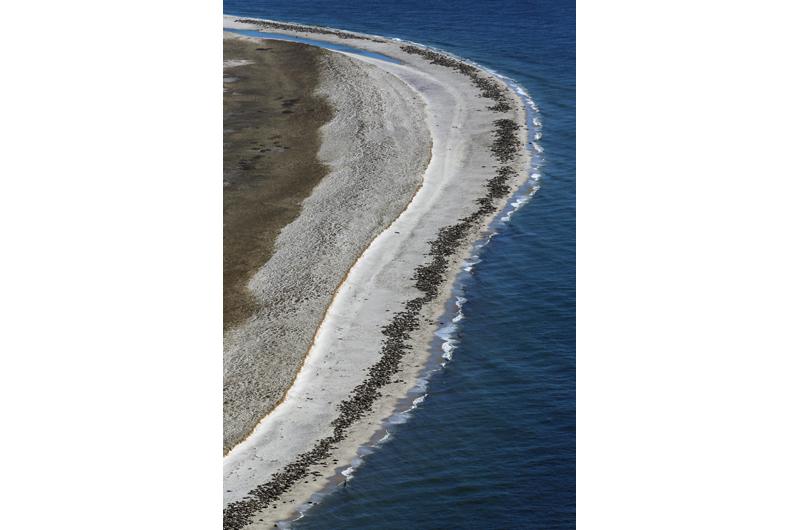
Virtually uninhabited – the only structure is an old Coast Guard boathouse – 292-acre Muskeget Island hosts the largest breeding colony of gray seals in Massachusetts. In the words of Crocker Snow Jr., the majority land owner who has been visiting the island for almost seventy years, Muskeget is “the diesel engine of the local seal population.”
For years, he said, there were very few seals, a small enough number that the scientists studying them gave them all names. The numbers started to build until there are now give or take 10,000 seals on the island during the winter, with no signs of plateau. In 2009 Snow, a former foreign correspondent who lives in Ipswich and describes himself as a nature lover, helped facilitate a conservation restriction on Muskeget, which is also a National Natural Landmark. He is committed to the island staying forever wild. But, he said, the seal population has grown so large that they are starting to move farther inland, toward the freshwater ponds, knocking down barrier bluffs, trampling seagrass, and, he believes, hastening erosion. He sees it as an ecosystem out of balance, which makes him worry about other species: short-eared owls, piping plovers, black-backed gulls, and especially the Muskeget vole, a type of beach rodent that is found only on Muskeget. Some twenty percent of pups on Muskeget have had traces of avian flu, which he hypothesizes may be a result of seals giving birth near freshwater ponds used by waterfowl, and may have implications for the transmission of viruses between birds and mammals.
“I am ever more concerned that the numbers of gray seals are undermining lots of other species, either directly or indirectly. It’s pretty obvious they are affecting, negatively changing, the ecosystem of this tiny little island,” he said. “One can say, properly, that’s what ‘dynamic change’ is. Things change, and this island changes, and now this is the dominant species. So it is. And you can say, ‘Let nature be nature,’ and I understand that argument. Well, we’re not doing that with gray seals, because they’re protected. Nothing natural about that.”
In response to concerns such as those raised by Snow, many scientists point out that seals are not new to the area, but are coming back to where they once were. “It’s sometimes hard for people here to see that as a return, because it’s been three generations now that people haven’t seen seals,” said Andrea Bogomolni, a seal researcher at Woods Hole Oceanographic Institution (WHOI).
“But they have been here,” she said. “And one of the reasons is why we’re all living here. It’s a very rich area with lots of fisheries and an ecosystem that’s coming back into balance with the protection of these top predators.”
Seals, of course, are not the most famous predator in local waters. White sharks, popularly called “great whites,” add seal to their diet when they visit the region during the summer and fall. According to Greg Skomal, shark biologist with the Massachusetts Department of Marine Fisheries, as sharks mature into teenagers and become large and strong enough to hunt seals, their teeth change into serrated cutting tools – all the better to grab sea mammals.
“They specifically come to areas where those seals occur in high densities,” he said. They don’t feed exclusively on seals, he pointed out, but instead add pinnipeds (seals, sea lions, and the like) to their diets when they spend time in areas with lots of them. “I imagine that they migrated here even when the seal populations were very low to take advantage of other feeding opportunities, but I think the presence of seals is really beginning to aggregate them,” he said.
There are other factors than the recovery of seals involved in the increased presence of sharks, however. White sharks are also in the process of rebounding from a heavily depleted population that first received protection with the passage in 1976 by the Magnuson-Stevens Fishery Conservation and Management Act. “It’s rebounding from low levels and in some ways it’s redistributing itself in response to the seals,” Skomal said. “Think of it as this new restaurant that’s opening up and it’s attracting more and more customers each year because its such a good restaurant. Some of that is the population in general increasing, but some of it is simply that sharks are aggregating in an area where there is feeding opportunity.”
Shark safety is being looked at closely on the Cape, including education about the presence of seals. The Islands are a bit behind, Skomal said, partly because of geographical distance. But he thinks the Vineyard needs to get on board and be forward thinking about educating the public, with a close eye to the south shore, from South Beach and Chappaquiddick to Squibnocket and Aquinnah. “What I say to folks is in the summer, and this is what’s important, in the summer if you see high densities of seals you’re probably not the only creature looking at those seals,” he added.
The Islands may be behind the Cape, but the whole region may be behind the West Coast, where people have long been grappling with pinnipeds – from sea lions taking over a protected beach near San Diego to seals eating salmon in the Columbia River. Hayes, the protected branch chief at NOAA, recently moved back to the East Coast after spending twenty years in Santa Cruz, California, where he said the seal and white shark recovery has been going on for longer and most surfers have white shark encounters to tell about.
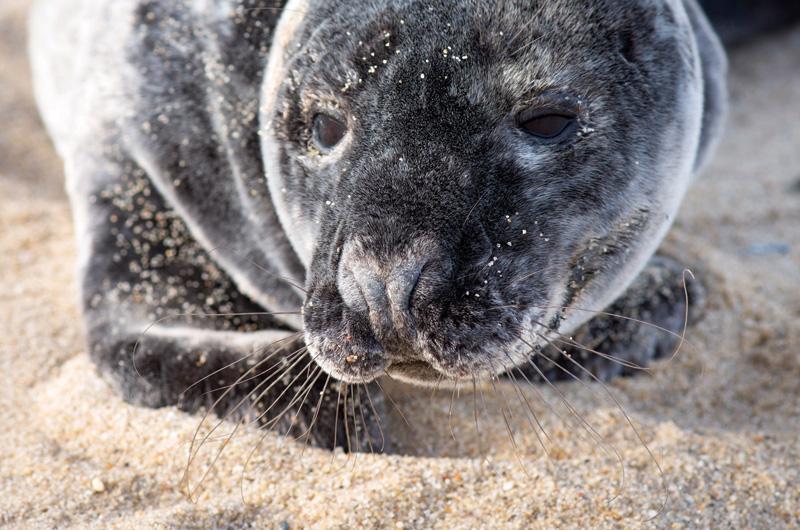
“There’s kind of a piece to it where people have come to accept, this is the reality of living in my environment, like a tornado or earthquake or hurricane,” he said. “I totally respect people’s fears about it, but I wonder whether, just because it’s novel here and Jaws is the bogeyman of Cape Cod, that this creates a particularly heightened awareness and cultural sensitivity.”
Probably no group is more concerned about the return of large numbers of gray seals to the waters south of Cape Cod than their ancient nemeses, human fishermen. Tensions are particularly high on Nantucket’s Great Point, a spit of land reaching up toward the Cape at the far northeastern end of the island where gray seals gather in large numbers. “You can hear them even before you can see them,” said Kennedy, who also oversees the Trustees of Reservations refuge at Great Point. He described a loud murmuring followed by groans as seals settle into the sand.
Great Point, as it happens, is also a favorite among anglers. “There’s true conflict on Nantucket between fishermen and seals,” Kennedy said. “If you’re fishing at Great Point, you are almost expecting you are not going to land the bluefish or striped bass on the end of your line. Once one fisherman loses a fish to a seal, usually the rest just pack it up and leave.”
Peter Howell, a fly fisherman and year-round Nantucket resident, said anglers used to visit Great Point from as far as Florida when the fish were running. “We’ve watched this situation develop for many, many years,” he said. “Some of the best fishing locations here on Nantucket have been largely preempted now by the gray seals.” The fall false albacore run was hit particularly hard, he said, because seals take the exhausted fish right off the line. “When you hook one, they’ll take off, they will run half way to Cape Cod on that first run,” he said. With the fish exhausted, the seal pounces, and “it’s gotten to the point where literally nine out of ten hooked false albacore will get eaten by the seals.”
About five years ago Howell helped to found the Seal Abatement Coalition, a group to “advocate for sensible management of our shores.” The coalition has a variety of views on seals, Howell said. Some would like to see them gone completely, he said, while others, including himself, see seal abundance as a good thing that needs to be kept in check. Last fall the abatement coalition and the Gray Seal Research Fund convened a symposium on Nantucket, attended by thirty stakeholders, to talk out issues. A “list of grievances” compiled by the coalition after the symposium included ecosystem imbalance, sharks, beach access, fisheries, lack of funding for seal research, and concern about the Marine Mammal Protection Act that protects the seals.
“There are virtually no practical effective natural controls over their population growth,” Howell said. “The question is, at what point do we see an imbalance between that one dominant species and all the other species...that’s my principal concern, that we are, I’m afraid, reaching that point.”
Howell pointed to differences between the Marine Mammal Protection Act and the Endangered Species Act, which provides a mechanism for species to be removed from protection when the species recovers. “Why spend taxpayer dollars administering and enforcing protection of a species that doesn’t need it anymore?” he asked. “Particularly if the situation is what I think we’re beginning to have here...where it’s not just a benign situation.”
NOAA is working on a list of proposed nonlethal deterrents that could be used by fishermen and on private property. Deterrents could include acoustic devices that would drive animals away from certain areas, underwater explosives (so-called seal bombs), and netting. But seal scientists said they were skeptical about relying on deterrents. “For the most part they don’t work for very long,” said David Johnston, an assistant professor of the practice of marine conservation and ecology at Duke University who has done work on seal population assessments and nonlethal deterrents. “The animals are really smart. They learn our behavior and so they react accordingly.”
A well documented case at the Ballard Locks in Seattle, where protected California sea lions were devastating stocks of protected steelhead salmon, shows the potential difficulty of deterrents. The sea lions were unfazed by detonating underwater firecrackers, being fed dead fish injected with bad-tasting chemicals, and barrier nets. Of thirty-seven sea lions that were captured and relocated 270 nautical miles away, twenty-nine returned. Of six that were taken all the way to California, four returned. Three of the worst offenders were finally taken to SeaWorld, after which the government reported success.
Bogomolni, the seal researcher at WHOI, said scientists need to work with the fishing community to find out what seals are eating. “This is why there was a bounty,” she said, “there was a perception of competition with these species, but it was never proven.” Preliminary results from studies now underway show that they eat sand lance, flounder, and hake, among other things.
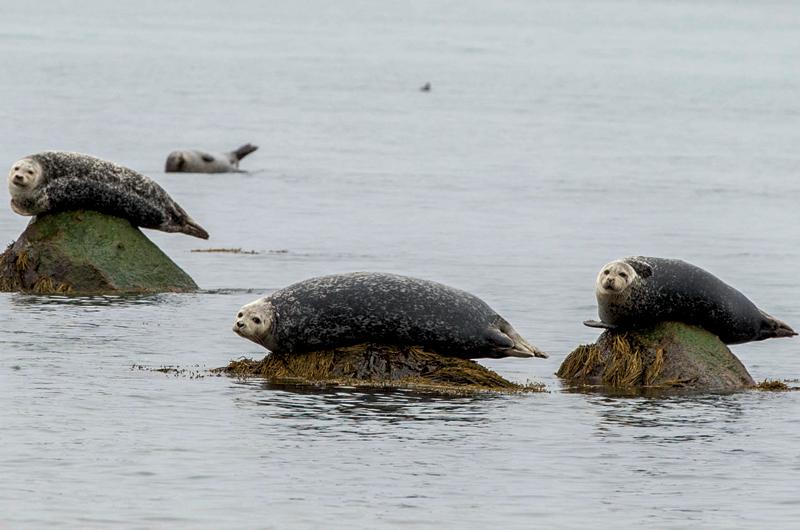
Virtually everyone agrees that more needs to be known about the interaction between seals, sharks, fish, and humans. “We don’t doubt that reports of seals depredating on nets is real,” said NOAA’s Hayes. “Is this having a half a percent impact on the revenue of fishermen, or is it having a 20 or 30 percent impact on that person? We just don’t know and we want to know.”
Funding, as always, is limited, and critically endangered North Atlantic right whales and Atlantic salmon have the highest priority in his office, Hayes said. Gray seals come in at number three not because they are endangered, but because of their robust population. Seals are being addressed at the highest levels of NOAA, he said, with the agency working to represent everyone, from the fisherman on Nantucket who wants the beach back to the person in the Midwest who wants to be able to visit and see seals.
Last summer a team led by Salem State University professor Jennifer Jackman surveyed Nantucket voters, fishermen, and tourists on their feelings about seals. Not surprisingly, perhaps, tourists liked seals the most while anglers liked them the least. But there were also areas of agreement. “We think of the science, the controversy over seals as being fraught with disagreement, but there was an important area of agreement among all groups. That was the importance of the ecosystem,” she said. All three groups were also largely opposed to lethal management of the seals, she said, though in varying proportions.
Jackman sees parallels with her other area of research, coyotes on Cape Cod, which have filled the role of apex predator in recent years. Two studies taken seven years apart, in 2005 and 2012, found that over time people had a more favorable view of the animals and there was less support for lethal management, she said.
“There’s kind of an adjustment that just needs to take place when people have become accustomed to being in an environment where predators have been removed,” she said. “They sort of see that as the norm without predators, and when predators come back there are complaints about them. And I think that’s what you see happening with coyotes and wolves in other parts of the country and what you see happening with seals.”
“As a conservation biologist I view this as an incredible success,” said Duke University’s Johnston. “We removed those animals from the U.S. They were gone. And then because we stopped killing them they’ve recovered and they are amazing animals.
“In many ways this conservation success story has been kind of lost,” he added. “Mostly because most of the people that live in the Cape and Islands area grew up in a world without very many seals, despite the fact that they were there in great numbers before people showed up.”
But is there a point where there are too many seals? “Ah, it’s a great question, isn’t it? It gets down to some of the core things, of how people really perceive animals,” Johnston said. “We always think that we can manage ecological systems. There’s a lot of hubris involved in that. If you look at other situations, people find that when they introduce species to get rid of other species, or try to monkey with ecosystems, they don’t often get the results they expect because they are so complex.
“So when people ask me, ‘What’s the right number of seals,’ I often counter back, ‘Well, what’s the right number of stars in a galaxy?’ It’s natural. It’s the number that we have, it’s the number that we interact with, and the number that we need to live with.”
What can be said for sure is, unlike stars, the number of seals Vineyarders will need to live with is rising. In Johnston’s opinion,“the best thing to do is to let nature run its course here. At some point the population will level out. And in the meantime we as humans have to figure out, ‘How do we live with seals?’”
The answer is “carefully.” While it is always a thrill to encounter a large wild animal, just before Memorial Day this year NOAA sent out a reminder about avoiding “selfies with seals.” The Trustees of Reservations is increasingly posting signs on its beaches, as it has for some time on Nantucket, warning residents to leave the animals alone for the safety of all species. “Their bite can be just as vicious as a dog’s bite,” said Kennedy. “That’s not the way to end the day at the beach.”
“Imagine the biggest German shepherd you’ve ever seen,” echoed the biologist Hayes, “with bigger teeth.”

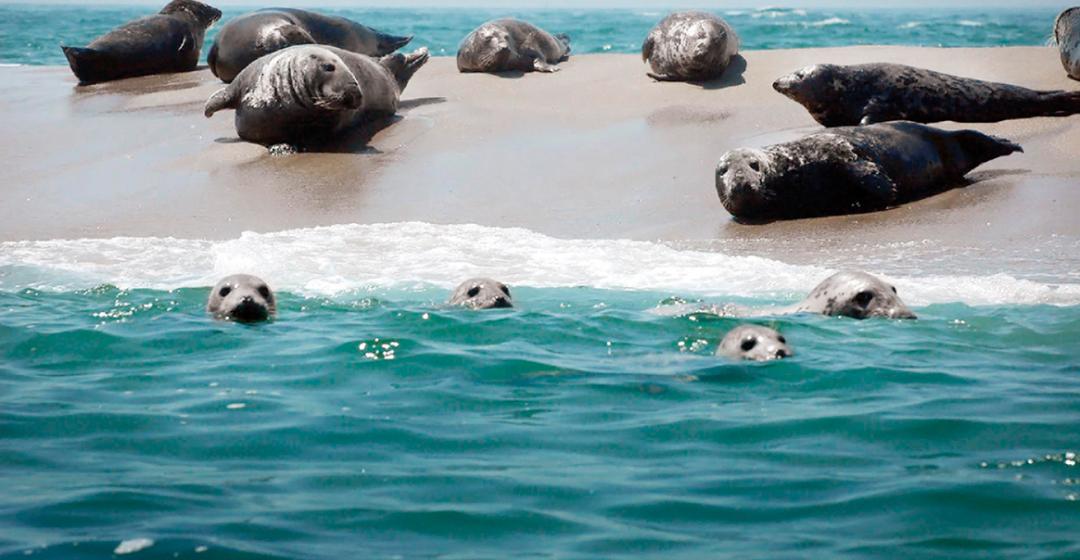


 6 comments
6 comments
Comments (6)